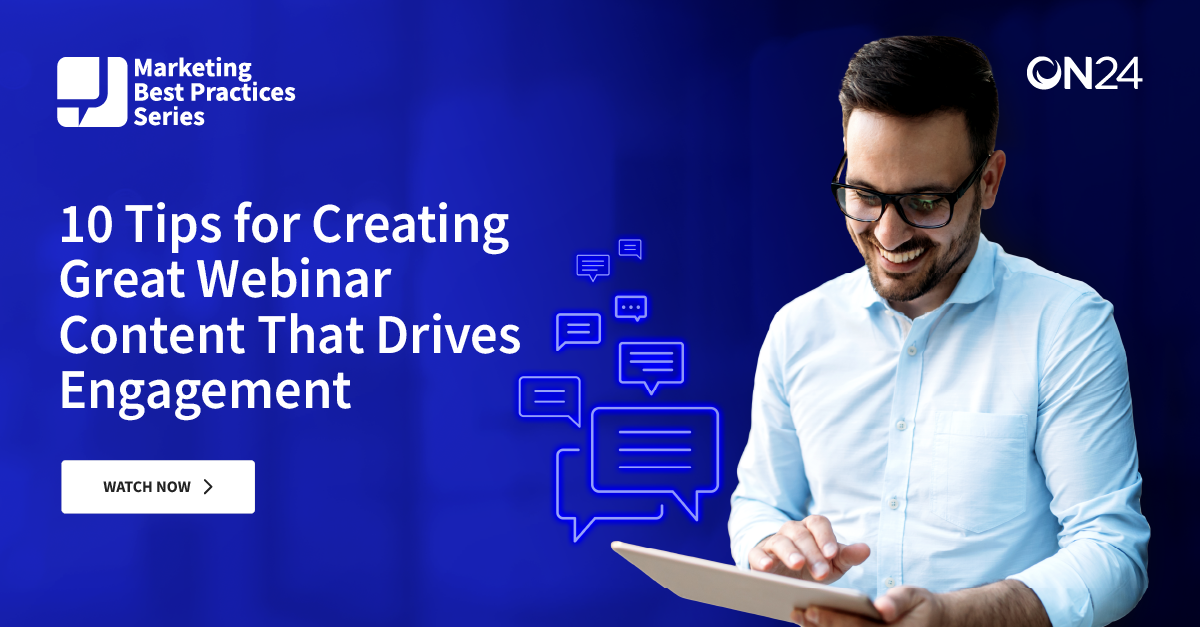Guide to Choosing the Perfect Webinar Format for Your Audience

Webinars provide organizations with a convenient way to both connect with audiences and drive business results. In fact, according to Content Marketing Institute, 47% of marketers say webinars produced the best marketing results in 2022.
Many factors determine a successful webinar, and the format you choose for it is one of the most important. Every audience segment comes with its own unique set of needs and preferences. Your chosen webinar format will influence how big an audience you attract, how engaged attendees are, and how impactful your webcast is in achieving your aims.
We’ve put this guide together to help you decide on the right format for your webinar, covering everything from the different formats to choose from to measuring your webinar’s success.
Determining the need for a webinar

Webinars are versatile and powerful tools for realizing diverse marketing objectives. But that flexibility doesn’t mean you can build a webinar without a plan; You need to decide what you’re trying to achieve before creating a webinar to get the most from it.
There are a lot of objectives for delivering a webinar, including:
-
- Educating an audience
- Attracting and nurturing leads
- Driving conversions
- Growing brand awareness
But, no matter your goal, designing your webinar to deliver genuine value to your audience is still essential.
Which webinar format is right for your content?
The versatility of webinars doesn’t just apply to their ability to adapt to diverse marketing aims. They’re also highly flexible to the content you want to deliver.
Some suitable content types for a webinar include discussion of niche topics, thought leadership, product demos, customer stories, research reports and training and certification. By understanding the content type you want to deliver, you can more effectively match your audience with the right webinar format.
Understanding different webinar formats

With an objective in mind, you can decide how to present that information. Here are some of the most common webinar formats to consider:
-
- Single presenter: A single speaker leads the webinar, offering focused expertise. This format streamlines communication but may limit the number of perspectives offered.
- Multi-presenter: This format features multiple presenters delivering unique presentations around a single or related topic. Often, all of the presenters participate in some group discussion or Q&A with the audience as a part of the experience.
- Panel discussion: Multiple experts or panelists engage in dynamic or scripted discussions, providing diverse perspectives. This format requires a moderator to be properly effective.
- Audience forum: This webinar format brings the audience into the experience by enabling them to participate in a moderated group discussion over video and audio. Often in a Q&A format, this format fosters direct engagement and ensures the audience’s specific queries are addressed.
- Practical workshop: Participants engage in hands-on sessions led by the host to gain practical skills or insights. This encourages interactive learning but requires planning to avoid technical difficulties.
- Product demonstration: This format showcases a product or service in action, helping the audience to understand its functionality in practice. However, it might not cater to the interests of the entire audience and requires flawless technical planning.
- Training and Certification: Many professional services and healthcare organizations rely on webinars to provide training and certification at scale. With training and certification webinars, you can provide professionals with the ability to earn required continuing education credits.
Each webinar format is best suited to different objectives. A panel discussion on a trending topic in your sector might be the ideal format for growing brand awareness, for example, while a product demonstration could be a good fit for converting leads into customers.
Creating webinar “programming”

Once you have matched the right webinar format with the right audience, you can then choose a programming style to make your webinar more approachable and maybe even fun. Today, webinars are more like TV viewing experiences than the talking PowerPoint presentations of old. Best practices content might be delivered in a news style format, a panel discussion format may be delivered as a talk show, a customer case study might have an informal interview format. The possibilities are endless.
Many companies will create serialized programs with an established format, style, host, and cadence to build a long-term audience. These serialized programs become the company’s sub-brands and are a great opportunity to build brand affinity and thought leadership in your space.
Webinar best practices checklist
Choosing the best format is only one part of the overall process for setting up webinars that can help you achieve your marketing goals. Here’s a more comprehensive checklist of webinar best practices to follow when you’re planning yours, helping you to create a webinar that’s set up for success:
-
- Set out an objective: Define a clear and specific objective for your webinar or, in other words, decide what you want to achieve by running it. This could be providing information or generating leads, for example.
- Choose your content focus: Figure out the primary theme or topic covered by your webinar content, ensuring it aligns with your audience’s interests and can contribute to your objective.
-
- Decide on the format: Select the most suitable webinar format based on the objective and content focus you’ve already chosen. The key to making the right decision here is to focus on the needs and interests of your audience. A single presenter format might work best if the content is high-level best practices. If it’s a step-by-step walkthrough of a process, a practical workshop could be a better idea.
- Decide on the format: Select the most suitable webinar format based on the objective and content focus you’ve already chosen. The key to making the right decision here is to focus on the needs and interests of your audience. A single presenter format might work best if the content is high-level best practices. If it’s a step-by-step walkthrough of a process, a practical workshop could be a better idea.
-
- Select speakers/participants: Carefully choose speakers or participants knowledgeable about the focus topic. Ensure you prioritize speakers who can provide diverse perspectives relevant to your webinar content.
- Select speakers/participants: Carefully choose speakers or participants knowledgeable about the focus topic. Ensure you prioritize speakers who can provide diverse perspectives relevant to your webinar content.
-
- Create engaging content: Develop your webinar content – a series of slides, a comprehensive script, or a mixed-media presentation – focusing on making it engaging. That includes building in sections for audience participation, if applicable, and thinking about how you can apply storytelling to building a cohesive narrative.
- Create engaging content: Develop your webinar content – a series of slides, a comprehensive script, or a mixed-media presentation – focusing on making it engaging. That includes building in sections for audience participation, if applicable, and thinking about how you can apply storytelling to building a cohesive narrative.
-
- Choose a platform: Determine how you will host your webinar, choosing an option that offers reliability and sophistication regarding available features. A dedicated webinar hosting platform like ON24 is often the best choice, delivering a professional experience alongside value-added features like audience analytics and conversion tools.
- Run a test: Conduct a thorough technical rehearsal before the webinar begins to test your hosting platform, check for timings, and catch any potential technical problems. This will ensure that your webinar runs seamlessly.
- Choose a platform: Determine how you will host your webinar, choosing an option that offers reliability and sophistication regarding available features. A dedicated webinar hosting platform like ON24 is often the best choice, delivering a professional experience alongside value-added features like audience analytics and conversion tools.
Promoting and marketing your webinar

Of course, setting up a webinar is only the start of the process. To be successful, you need to attract an audience. To do that, you need to market your webinar.
You can use the full range of marketing channels to build an audience and encourage webinar signups, but several methods are particularly valuable. Social media and email marketing are the two with the best potential, for different reasons.
Through email marketing, you can engage your existing audience and database. Since many of them are already familiar with your brand, they’re more likely to be interested in your content, which increases the likelihood that they’ll attend.
Social media offers a slightly different opportunity. The pay-per-click offering on platforms like Facebook and LinkedIn allows you to create well-defined target audiences based on demographic details, interests, job titles and more. This means you can optimize your advertising campaigns only to target your ideal audience members, making it easier to spend your budget efficiently.
Other channels, like SEO and partnerships with other businesses, can also help you to build awareness about an upcoming or on-demand webinar. For the best results, take a multi-channel approach to maximize your coverage.
Engaging your audience: Tips and Tricks
Even if your webinar ticks all the boxes — from having great content delivered in the perfect format to featuring the right speakers — you still need to consider engaging your audience throughout the event.
Webinars take longer than other marketing content forms, so keeping your audience engaged will be critical.
Regardless of the main format you use for your webinar, a tactically placed poll can help keep your audience’s attention. Q&A, quizzes, surveys, gamification and even breakout sessions can be a break from the main content while giving specific audience members the chance to get directly involved.
Remember that engagement opportunities are a great way to recap sections of your content and help your audience reinforce what they’ve learned.
Post-Webinar activities and follow-ups

The webinar marketing funnel doesn’t end when your webinar is completed. You can plan plenty of post-webinar activities to help achieve your objectives. What these are depends on what objective you set at the beginning of the process, but they might include:
-
- Sending out recordings/hosting your webinar: You can extract more value from the effort you put into creating your webinar by making it available to watch even after the live date. You can do this by hosting it on your website or a video-streaming platform and sending it out to attendees.
- Gathering audience feedback: Post-webinar surveys or focus groups can help you get quantitative and qualitative feedback on your webinar. This can be invaluable if you plan to produce more webinars, giving you insights that help you to improve your approach.
- Analyzing audience data and engagement metrics: Dedicated webinar hosting platforms like ON24 offer built-in analytics, which can help you understand how your webinar performed quantitatively. You can use these analytics to delve into the details of your audience, see average watch times, check out engagement metrics, and more.
- Nurturing warm leads: If your webinar was designed to attract or nurture leads, the period immediately after it presents an excellent opportunity to follow up with the warmest leads and see if you can move them deeper into the buying journey by offering a product demonstration, for example.
- Sending out recordings/hosting your webinar: You can extract more value from the effort you put into creating your webinar by making it available to watch even after the live date. You can do this by hosting it on your website or a video-streaming platform and sending it out to attendees.
Measuring webinar success

The final step in the webinar process is to attempt to measure how it went. This can help you to understand where you succeeded and where there’s room for improvement. With that information, you can make your next webinar even better.
The primary metrics for webinar success depend on your event’s overall objective. If you aimed to drive conversions, for instance, then the number of meetings booked from your webinar generated directly will give you an indication of how well it performed.
But you can delve deeper into the data using your chosen webinar hosting platform’s proprietary analytics. First-party metrics like questions asked, poll responses, downloads, CTAs clicked and overall engagement rate can all deliver useful insights into how well you performed.
With a webinar hosting platform like ON24, you seamlessly send attendance and engagement data directly to your sales force and wider marketing organization via CSM and MAP integrations. This empowers more effective selling and gives each account a unique, personalized experience with your brand.
Making the most of your webinar
Although choosing the proper webinar format is only one part of the creation process, but it’s essential to its success. If you choose the right format for your objective and content, you’ll be on the path to achieving excellent results.
Now that you’ve learned how to build a webinar through the above guide, you’re all set up to attract a large audience, engage them thoroughly, and realize your KPIs.

